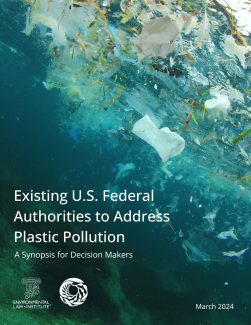Plastics Pervade the Economy and Their Harms Are Hard to Regulate

Our modern society is built with plastics. They are ubiquitous, and can be found in every corner of the human economy. Alas, also seen everywhere is plastic waste. And the problem is not just visible trash, as with discarded plastic bags, highways strewn with broken automobile parts, and the huge oceanic trash gyres.
Indeed, worse results come from weathering, abrasion, microbial action, and sunlight breaking down discarded plastics, creating an array of potentially dangerous micro- and nanoparticles that infiltrate the ecosystem and the marine and terrestrial foodchains.
The existing evidence of the impact of microparticles on human health is concerning, as they have the greatest potential to harm our brains and fetuses growing in utero.
To address the pressing need to better manage plastic waste, EPA last year published its Draft National Strategy to Prevent Plastic Pollution. The agency proposes a circular economy to recycle and reuse plastics, thereby diverting them from landfills and the natural environment.
At first glance, a circular economy for plastics seems an eminently sensible approach to sustainability. At its core is an analogy between plastics in a human economy, and wood in a natural forest. Both are pervasive structural elements. And both have a limited life and (in theory) can be recycled and reborn.
When a tree dies, a diverse community of scavengers, including fungi, bacteria, insects, and plants, capture energy embedded in the wood, and reuse scarce naturally produced chemicals in the dead tree. These organisms enrich the soil, too, helping seeds from the expired parent sprout a yearling tree and start the cycle over again.
We might hope to design an economic system, the concept of circularity states, that affords similar recycling of plastics.
However, when wood breaks down in a natural ecosystem, the waste of one scavenger becomes the input for yet another scavenger. So the circularity analogy only goes so far, because degradation of plastic often makes the problem worse, as when a large piece of trash breaks down into dangerous micro- and nanoparticles.
As one measure of the practical challenges facing chemical engineers and toxicologists doing research that might lead to a circular economy, see the environmental engineer H. Wiesinger and colleagues' recent review paper “Deep Dive Into Plastics, Monomers, Additives, and Processing Aids.” They estimate there are over 10,000 different chemical compounds related to plastics, of which 2,400 are potentially hazardous to humans.
The pervasiveness of plastics in our consumer life is deeply connected to the dependence of the U.S. economy on fossil fuels. Indeed, the industrial processes to manufacture plastic start with oil and natural gas feedstock.
But whereas in our fossil fuel economy energy is abundant, in natural ecosystems energy, and the constituent chemicals to build living organisms, are typically quite scarce. Because of the profligate abundance in our human economy of fossil energy and everything we derive from it, economic actors have little incentive to develop innovative ways to recycle and reuse.
Because of that energy scarcity in the natural world, over literally billions of years there has been evolutionary pressure for living organisms to develop intricate ways to scavenge waste energy and waste chemicals. By contrast, the human economy has a scant century of experience innovating with the technology of oil and plastics. And we obviously have much left to learn.
Where EPA proposes in its Draft National Strategy a top-down approach to a circular economy, complete with multiple bulleted points, the recycling and reuse in natural ecosystems was all created bottom-up, through evolution by natural selection acting on individual species, to create multitudinous chemical pathways to break down waste. It is preposterous that a top-down regulatory approach could ever create the diverse chemical and economic pathways needed to effectively address the diverse chemicals and particle sizes in plastic waste.
For better or worse, the number of plastic chemicals in commerce will continue to burgeon. To better compete economically, corporations have the incentive to create ever more kinds of plastics. Moreover, because intellectual property law protects many existing plastics, other chemicals, and related processes, economic actors are forced in novel directions, thereby exacerbating the problem of too many chemical compounds and their harm to human health and the environment.
Plastics Pervade the Economy and Their Harms Are Hard to Regulate.


